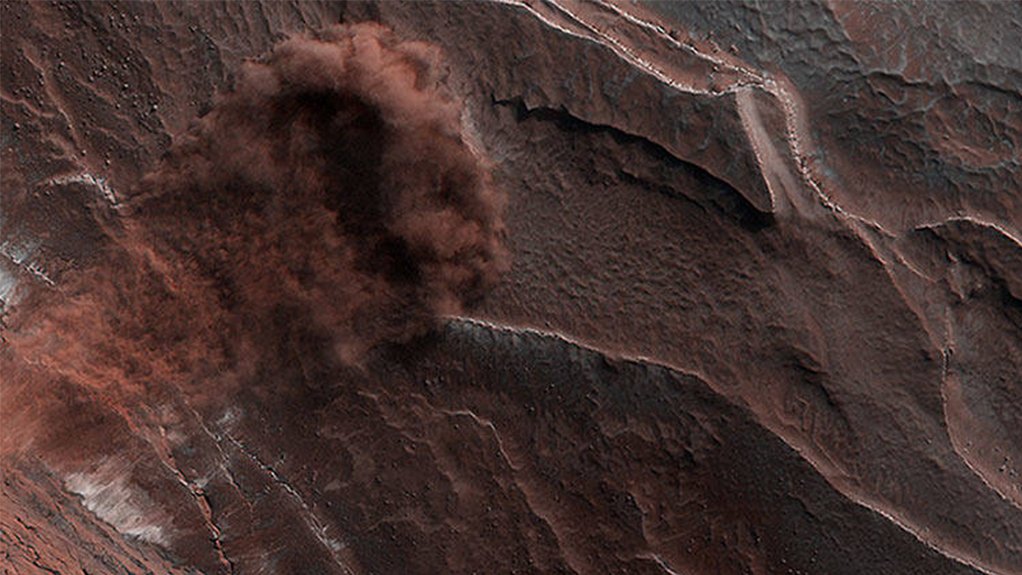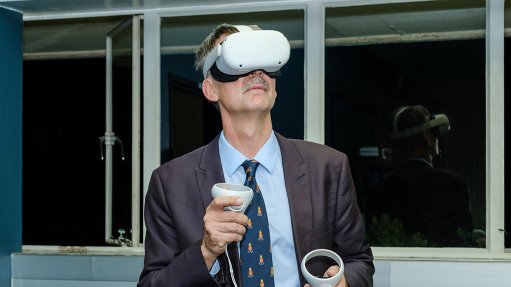Avalanche caught in progress on Mars by Nasa spacecraft


Caught in the act: an avalanche races down an escarpment on Mars.
Photo by Nasa/JPL-Caltech/University of Arizona
The US National Aeronautics and Space Administration (Nasa) has just released this photograph of an avalanche in progress on the surface of Mars. The avalanche was caught by the HI-RISE imager on Nasa’s Mars Reconnaissance Orbiter (MRO) spacecraft.
The avalanche took place in Mars’ northern polar region in late May, during spring. With the rising temperatures, ice vaporises (Martian atmospheric pressures are too low to allow liquid water on the planet’s surface), destabilising ice blocks, which then break loose and slide down into the valley below. In the process they kick up lots of dust.
The cliff on which this avalanche occurred was about 500 m high. Also visible are layers on the surface of the Martian north polar region during spring.
HI-RISE is an acronym for High-Resolution Imaging Science Experiment. It operates in the visible and near-infrared wavelengths and is equipped with a telescopic lens. MRO has three other imagers, plus an imaging spectrometer, and an array of other experiments including a shallow ground-penetrating radar.
The spacecraft was launched in 2005 and arrived in Martian orbit in March 2006. It had the prime mission of researching the history of water on Mars. Its primary mission was meant to end in December 2010, but the MRO is still going strong, its mission having been extended several times.
The spacecraft is powered by solar panels and has no less than 20 thrusters, of which only eight are used (along with reaction wheels) to control the spacecraft in Martian orbit. (The other 12 thrusters were used for course corrections during interplanetary cruise and for deceleration into Martian orbit.) The MRO also acts as a communication relay station for Nasa landers and rovers on the Martian surface.
Comments
Announcements
What's On
Subscribe to improve your user experience...
Option 1 (equivalent of R125 a month):
Receive a weekly copy of Creamer Media's Engineering News & Mining Weekly magazine
(print copy for those in South Africa and e-magazine for those outside of South Africa)
Receive daily email newsletters
Access to full search results
Access archive of magazine back copies
Access to Projects in Progress
Access to ONE Research Report of your choice in PDF format
Option 2 (equivalent of R375 a month):
All benefits from Option 1
PLUS
Access to Creamer Media's Research Channel Africa for ALL Research Reports, in PDF format, on various industrial and mining sectors
including Electricity; Water; Energy Transition; Hydrogen; Roads, Rail and Ports; Coal; Gold; Platinum; Battery Metals; etc.
Already a subscriber?
Forgotten your password?
Receive weekly copy of Creamer Media's Engineering News & Mining Weekly magazine (print copy for those in South Africa and e-magazine for those outside of South Africa)
➕
Recieve daily email newsletters
➕
Access to full search results
➕
Access archive of magazine back copies
➕
Access to Projects in Progress
➕
Access to ONE Research Report of your choice in PDF format
RESEARCH CHANNEL AFRICA
R4500 (equivalent of R375 a month)
SUBSCRIBEAll benefits from Option 1
➕
Access to Creamer Media's Research Channel Africa for ALL Research Reports on various industrial and mining sectors, in PDF format, including on:
Electricity
➕
Water
➕
Energy Transition
➕
Hydrogen
➕
Roads, Rail and Ports
➕
Coal
➕
Gold
➕
Platinum
➕
Battery Metals
➕
etc.
Receive all benefits from Option 1 or Option 2 delivered to numerous people at your company
➕
Multiple User names and Passwords for simultaneous log-ins
➕
Intranet integration access to all in your organisation



















